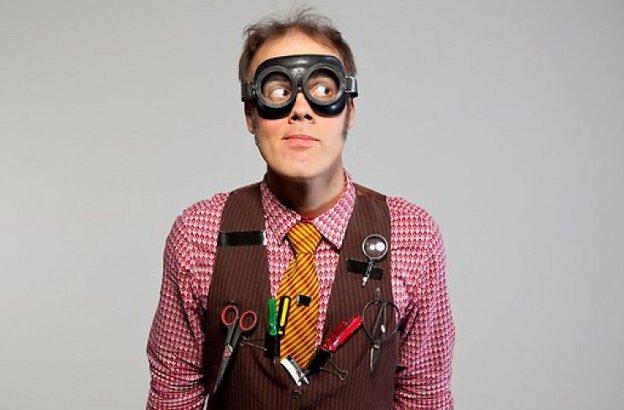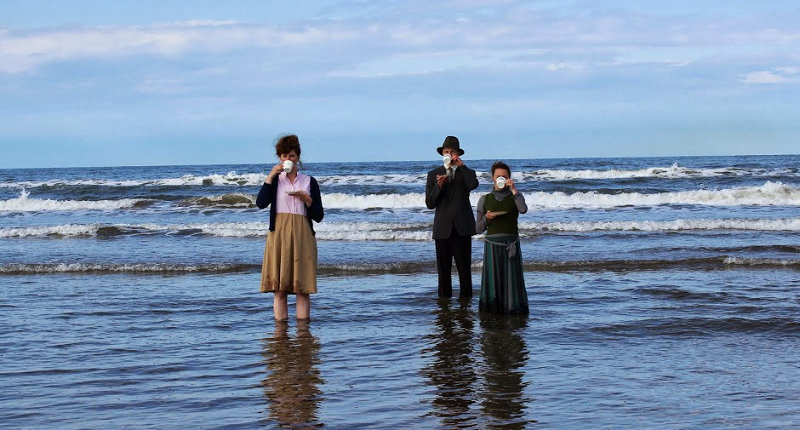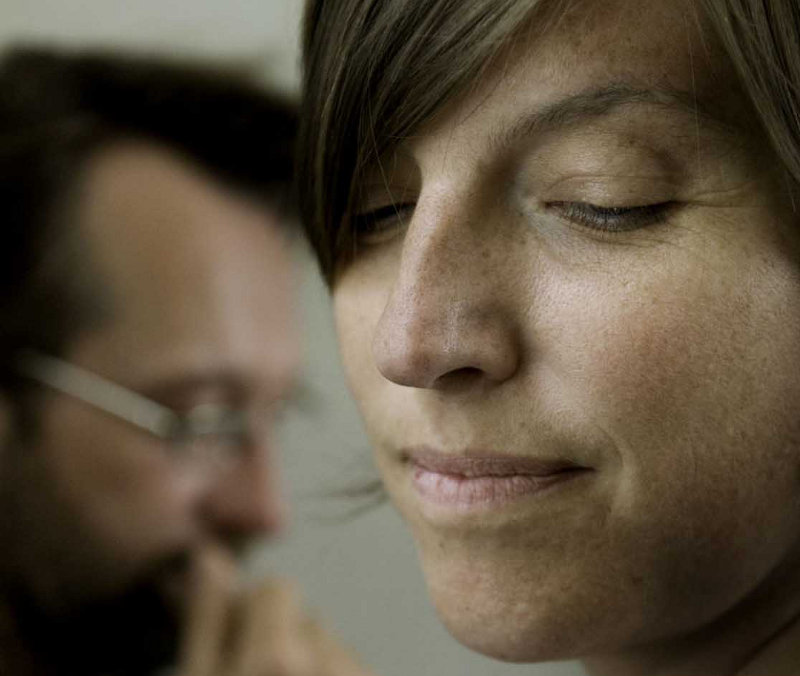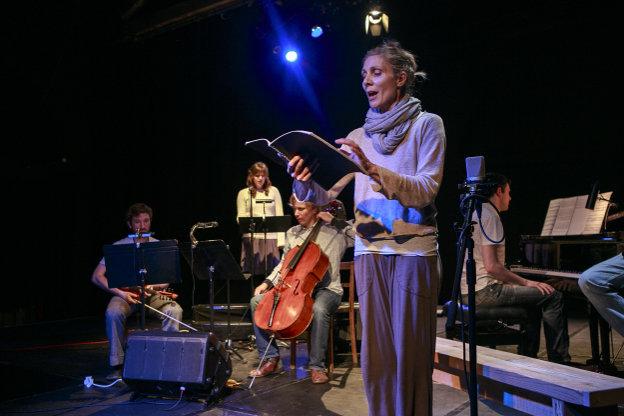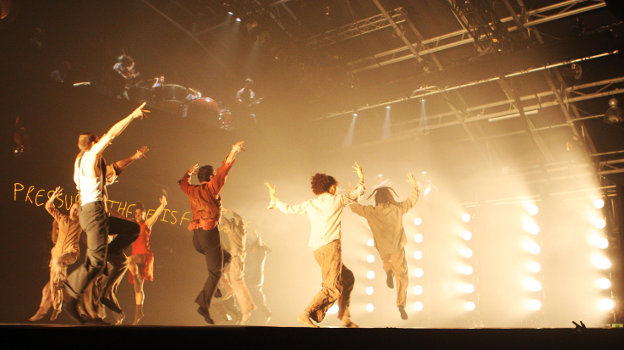
Ebrington is a huge and chillingly evocative reclaimed military complex turned new civic centre on the East bank of the river Foyle (and the destination of the EU-funded Peace bridge which now, stunningly, connects the two halves of the city, Catholic and Protestant). It is here that Derry-Londonderry City of Culture have chosen to stage a specially reworked version of Hofesh Shechter’s Political Mother in a state-of-the-art pop up venue. As the audience stream across the new bridge in their hundreds, and local teenagers beat out a summoning tattoo on the city walls, this feels like a dance show that has transformed into a civic event. The pop-up theatre is more like a stadium: with space for 3000 in its cavernous arena plus a token rake of seating, for those traditionalists who prefer to sit for their culture, right at the back.
But Shechter’s particular combination of overwhelming sound and blood-raising light show, underpinned with identifiable dance languages, creates an experience that’s very difficult to take sitting down. In a gig-like staging with the 1200-strong audience standing to gaze up at the stage we are met with a three-tiered bank of musicians: an instrumental wedding cake of military snares, under classical string group, under thrashing rock band. Beneath and before them, dancers judder and chase. The overwhelming effect of Shechter’s choreography is achieved through its recurrent gestures, repeating and reforming in diverse contexts: gestures that resonate with feelings of desperation and powerlessness, supplication, transfixion. Set against this is the irrepressible impulse to move which bubbles up from the production’s heart.
For Shechter, dance is about feeling not thinking, about identity not politics. But of course, in Derry, identity is politics and the piece has an extraordinary resonance here. Witness the line of military men snapping snared rhythms in regimented style and the agonised cusp of a private execution. Our standing figures in the arena echo the dancers, who, with their backs turned, gaze in adulation at a rock-star turned dictator. There’s a tension here, with Shechter himself in the central role: ‘resist this tyranny’, he seems to be saying, at the same time as beating our senses into submission in this feat of auteur-ship, which he himself composes, directs and performs.
Political Mother isn’t, of course, a new show, having toured to great acclaim since 2010. It’s a new project in Derry, however, adapted by producing partners LIFT to be even more specific to the context for which it was already so apt. There’s a new section that Shechter has worked in – a shadowy Irish folk dance segment, met with glee by the local crowd, where musicians playing traditional instruments wander satyr-like around the stage in the dimmest of lighting states – that feels almost like it’s slipped out of a mythical netherworld. And the local resonance is further banked by the presence in the project of local young musicians, twenty of whom were auditioned to become fully paid-up members of Shechter’s band for the seven-week rehearsal and performance period. This initiative unites the social, economic and artistic ambitions of Derry-Londonderry, an area of alarmingly high youth unemployment, empowering both the show and the festival to really lay claim to the city’s imagination.
A further addition is the Shortcuts programme, wrapping around the show and around the city. On one wet Saturday afternoon five local community groups showcase a series of short responses to Political Mother – initially planned to take place in different locations across the city but due the weather under one roof – having worked for the past ten days with the company’s world-class dancers to translate the ideas and experiences of the show for its young participants and their families. As we huddle in the drizzle watching keen groups of young men and women from wildly diverse backgrounds rehearse the evocative postures and gestures from the show on their own terms, it’s possible to discern the scope of the festival’s underlying ambition – to transform the city not only transiently but by offering transformative experiences, especially for its young people, that might propose genuinely new perspectives. It’s the openness and resonance of Shechter’s imagery and movement that invites re-contextualisation, invites these participants to own it.

Derry-Londonderry young people respond to Hofesh Shechter’s Political Mother
Derry was announced as the UK’s first City of Culture in 2011. Funded by the Department of Culture Media and Sport in a time of austerity and financial anxiety, when the arts sector as a whole is facing in-year cuts, the investment such a title represents is hugely significant. The strategic significance and visibility of the festival is hard to underestimate: it’s possible to read the programme here both as an experiment into the civic possibilities of culture and as a massive act of advocacy.
Nestled in the crook of the river Foyle, Derry is a town of just 115,000 and a site of long-entrenched conflict. The city walls which encircle it were originally built by imported City of London apprentices in the seventeenth century, but even these aren’t the most visible representations of the sectarian troubles that have racked this corner of Northern Ireland from that time on. Outside the city walls in Bogside (once barricaded as Free Derry), powerful murals and slogans still adorn the walls of houses, memorialising passionate strife. Inside the walls, most civic buildings are pockmarked by the debris of explosions that mark out this small, picturesque town as a site of battle. Derry was the context of the Bloody Sunday massacre, whose analysis was only concluded after two years’ of Enquiry culminating in David Cameron’s public apology in 2010. Yet this small town, awash with a bitterly contested history where even its name is in dispute (Derry to nationalists, Londonderry to Unionists), saw off competition from heavyweight cities such as Birmingham, Norwich and Sheffield.
The Festival’s response is to use both of these names, a gesture that encapsulates the approach of the programme as a whole – to bring together what has been divided, including artforms and experiences that might traditionally live apart. An unbelievably packed year of events includes large-scale new (or adapted) works from Walk the Plank, Theatre Mladinsko Ljubljana, and Boy Blue, to cherry-pick just a few of the theatre highlights. It also incorporates a range of fantastic local festivals including the Gasyard Wall Féile, the biggest community and arts cultural festival in the North West of Ireland, set in the charged settings of Bogside and Brandywell; and street theatre extravaganza the Carnival of Colours. Large-scale and community-led, high art and popular culture work together to re-vision a place so long defined by its troubles. Two key total theatre companies – Hofesh Shechter and Walk the Plank – form the centerpiece of the performance programme by creating large-scale events with the capacity to be both unifying and provocative.
Walk the Plank’s city-wide extravaganza, The Return of Colmcille, taking place the weekend of 7-8 June 2013, is a case in point. Its story transplants the historical first-century priest Colmcille, one of Derry’s most famous sons, into a journey across the vista of the city’s history. Colmcille – a man who, during the course of a long pilgrimage to Iona and, from this base, across Scotland, had an inspirational effect on Scottish nation building – is a unifying figure who embodies many of the values the festival seeks to promote. Placing the ideas he represents in dialogue with some of Derry’s history through the ages – including the surrender of German U-boats here during World War II, the flight of Amelia Earhart, and gigs with the Undertones – allows for a playful interrogation of the role such values may yet be able to play in Northern Ireland and the contemporary world. The script, by Olympic Opening Ceremony writer Frank Cottrell Boyce, will combine these elements, unfolding a pageant on the river and through the streets, and the project’s approach, in common with Political Mother, builds in significant contributions from local young people and adults who will perform and dance as various characters (such as Irish dancing shirt factory workers and nautical characters from Vikings to U-boat commanders) in themed segments. It is the cross artform inclusivity of Walk the Plank’s work, which combines large-scale spectacle and carefully crafted visual events with a witty overarching narrative and powerful choreographic segments, that promises to make the show broadly accessible and spectacularly inspiring.
The strategic roles ‘total theatre’ artists play in the programme (in Shechter’s case, the opening weekend; for Walk the Plank, on a central, half-term summer’s weekend when large numbers of visitors are projected) reflects the festival’s desire to curate iconic, cross artform events that can capture the public’s imagination. We might also discover in this a comment on the particular effectiveness of contemporary performance that spans theatrical languages to offer an inclusive and exciting experience for diverse audiences.
In a city of this size, the festival not only acts as a catalyst for new ideas and experiences but also has the potential to touch the entire community and to establish a different identity for a city known too-often only for its conflicted history. Derry-Londerry City of Culture is an exciting experiment into the scope and potential for artistic intervention on the social and economic, as well as imaginative, scales. And its going to be repeated, with competition already fierce (and somewhat heated) among cities wanting to host the 2017 programme. One inspiring lesson from Derry is the dynamic and effective role total theatre artforms can play in facilitating this vision.
Derry-Londonderry is UK City of Culture for the whole of 2013; for more on the events spanning the year see the official website. Political Mother: Derry-Londonerry Uncut ran 8-9 March 2013 at The Venue, while Walk the Plank’s The Return of Colmcille will play city-wide 7-8 June 2013.

